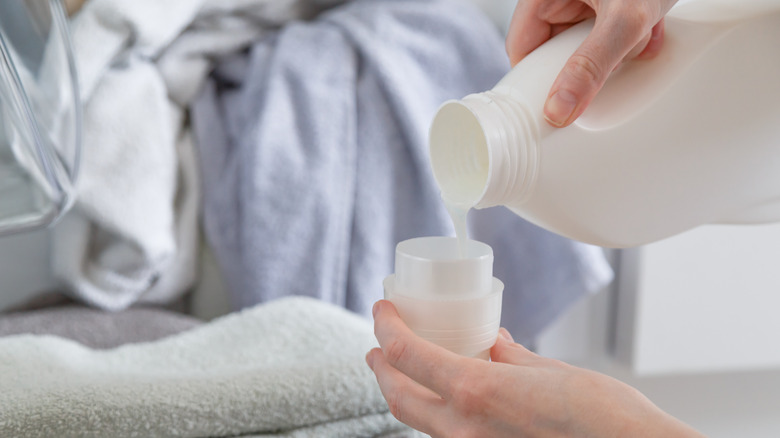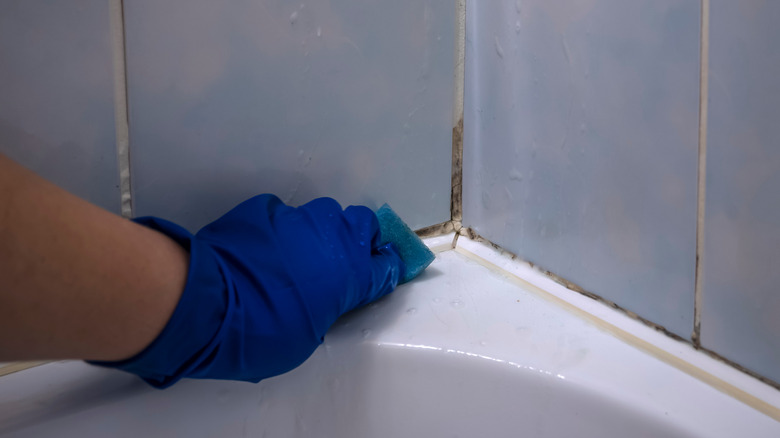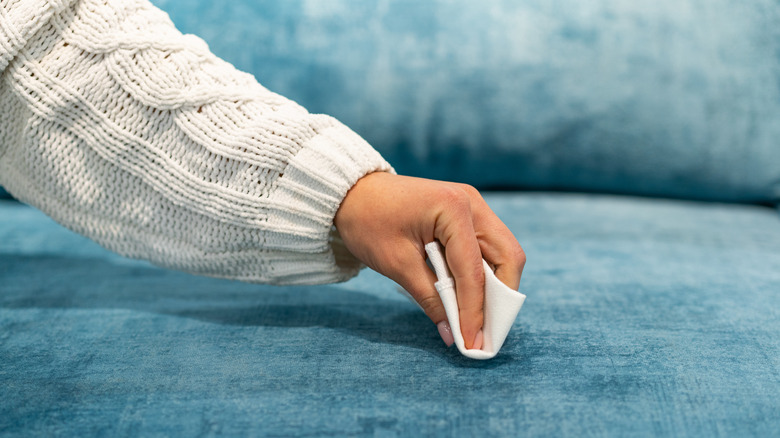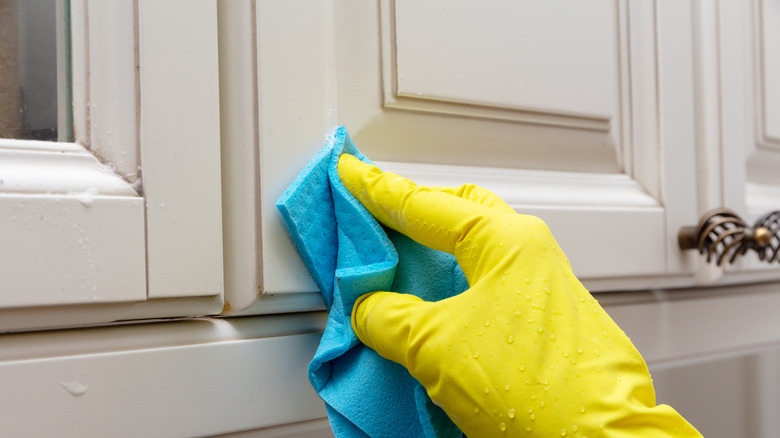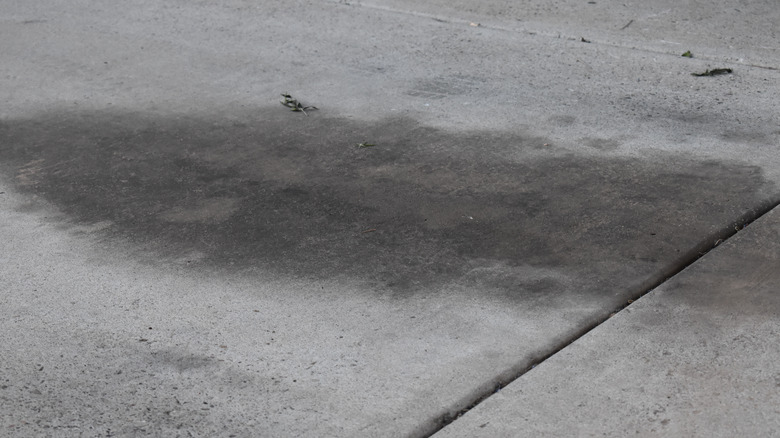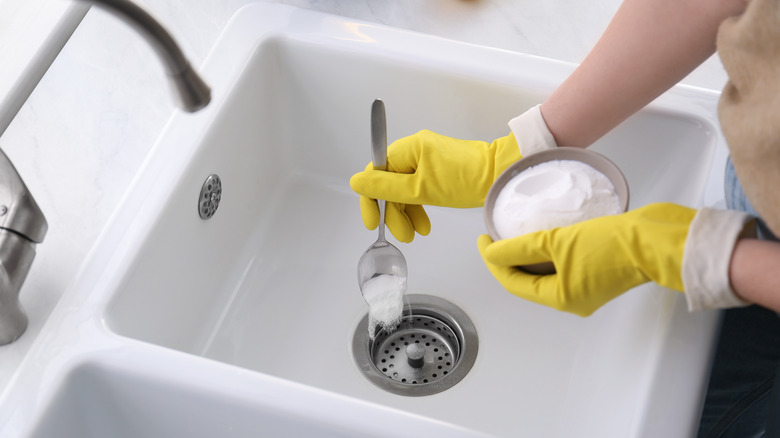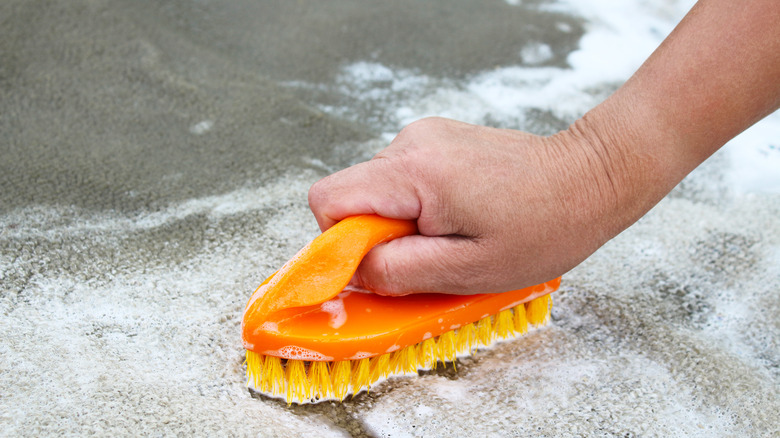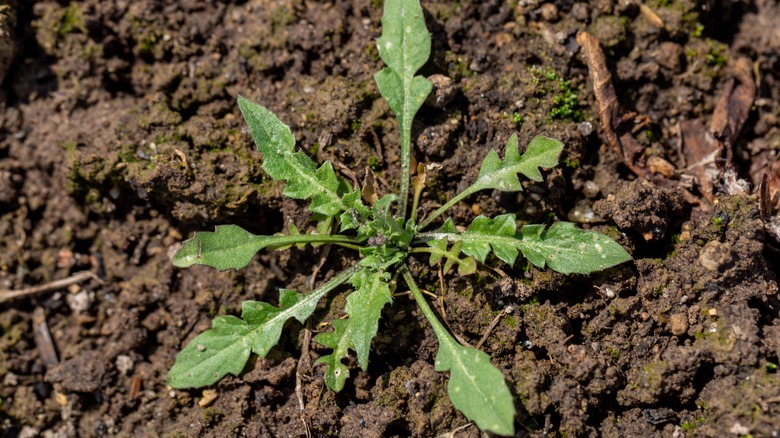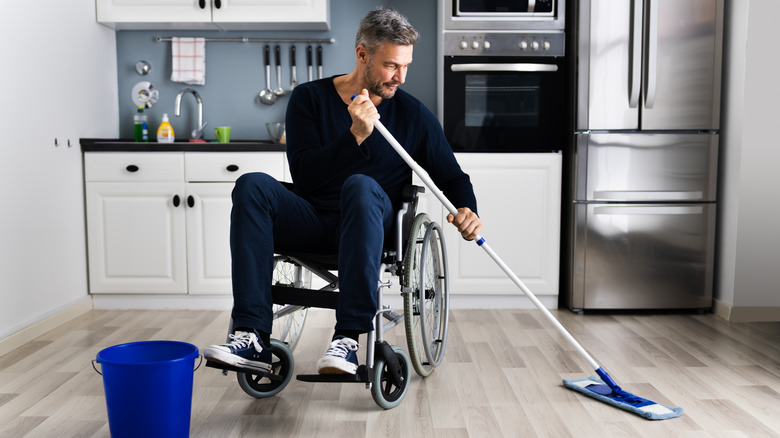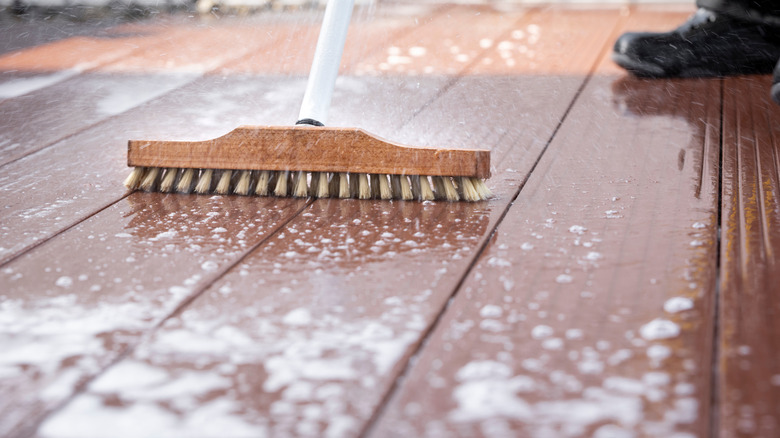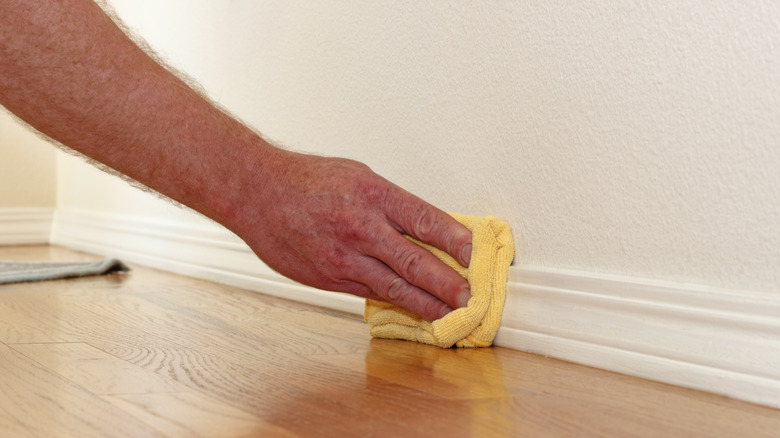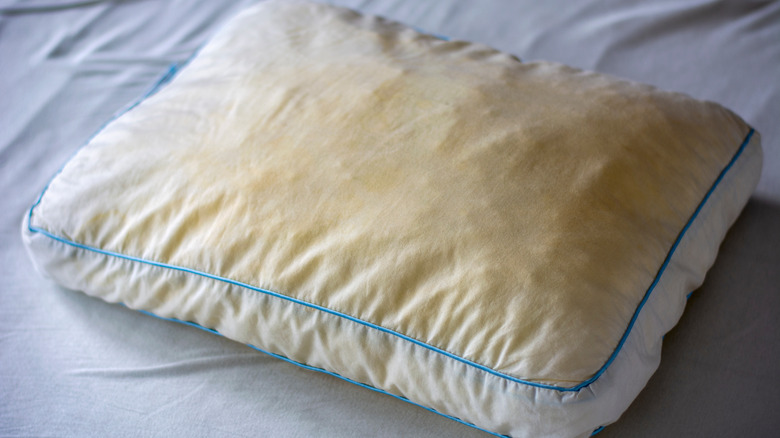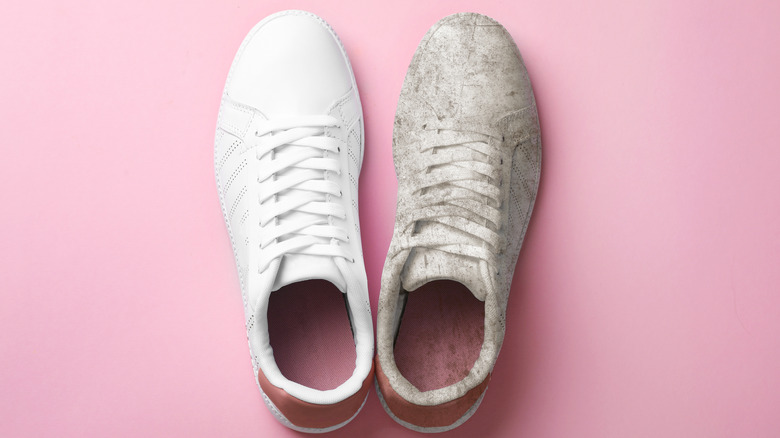12 Surprising Uses For Old Laundry Detergent Around The House
Laundry detergent helps remove dirt, stains, and odors from clothing. But did you know it can also come in handy for several tasks around the home? That's right, you can use laundry detergent for everything from cleaning the bathtub, killing weeds, and even unclogging a blocked drain. Before we get into some of the surprising ways you use laundry detergent, it is important to have a general understanding of three of the main types: liquid, powder, and HE.
Some of the uses will require one of these detergent types, and using the wrong type could adversely impact the results you'll see. Clearly, the consistency of liquid and powdered detergents is very different, which allows each type to lend itself to different types of tasks. HE variations are designed to be low-sudsing, so you'll want to pay close attention to any uses that call for this type of detergent. Using a standard liquid detergent could leave you with a sudsy mess if you use it in place of an HE detergent. Read on to learn more about ways you can use laundry detergent outside of the laundry room.
1. Cleaning the bathtub
Is your bathtub looking grimy? Does it have a lot of soap scum residue that you just haven't been able to get rid of? Well, some laundry detergent can help you get your bathtub looking clean and shiny in no time. Depending on your specific needs, you can use either liquid or powdered detergent. If you just need to give the tub a general cleaning or get rid of some dirty spots, mix liquid detergent with a little water and dip a sponge or scrub brush in the mixture. Scrub the bottom and sides of the bathtub, paying extra attention to any dirty spots. Then, simply rinse everything away with some warm water.
If you're dealing with built-up soap scum, you'll want to use powdered laundry detergent instead. Mixing the powder with some water will give you a paste that you can scrub into the soap scum to release it from the tub. After scrubbing, let the detergent sit on the affected areas for at least 15 minutes before rinsing it away.
2. Cleaning upholstery
You can also use laundry detergent to clean your upholstery fabric. However, because they are all different, you'll want to start by checking the care label from the manufacturer. These labels should include a code, either W, S, WS, or X. Fabrics with a W can be cleaned using water-based solutions. Laundry detergent is water-based, so you can use it on this upholstery.
Combine a little liquid laundry detergent with some warm water. Then, dip a microfiber cloth in the mixture and use it to dab at any stains. Take care not to rub the stains, as it could cause them to set more deeply into the fabric. Frequently rotate the cloth to make sure you are using a clean section each time you touch it against the fabric. After getting the stain out with the laundry detergent, use a clean towel dipped in plain water to wipe away any residue. Blot the fabric dry using a third towel.
Similarly, you can also use laundry detergent to clean the upholstery in your car. After vacuuming the seats to get rid of loose debris, dampen a microfiber cloth with warm water and a small amount of laundry detergent (only about ⅓ to ½ tablespoon). Wring out any excess moisture from the cloth before working in a circular motion to wipe down the upholstery. Use a fresh microfiber towel dampened with water to wipe over the surfaces one more time to remove the detergent residue, then let the upholstery air dry. If possible, open up the windows to increase air circulation.
3. Cleaning kitchen cabinets
Are your kitchen cabinets covered with dust and splatters from cooking food? If so, the perfect cleaner may be sitting in your laundry room. When cleaning kitchen cabinets, you should steer away from any abrasive cleaning products or tools. Laundry detergent meets this criteria, which is one of the reasons it can be a good solution. Moreover, because laundry detergents are formulated to fight grease (while typically on your clothes), they can also be helpful in removing some of the greasy build-up that may be covering your kitchen cabinets.
Mix liquid laundry detergent with some water to dilute it before cleaning. Aim for a ratio of two parts water and 1 part laundry detergent, or about 1 cup of water and ½ cup of laundry detergent. To clean the cabinets, dip a microfiber cloth into the cleaning solution. Use it to wipe down one or two cabinets at a time. Then, pause to wipe the cleaned cabinets down with plain water and dry them with a clean microfiber cloth. This will help prevent the cabinets from staying too wet, which could damage their finish or potentially cause the wood to warp.
4. Cleaning up oil spills
Oil spills in the garage or driveway can be a real pain to clean up. They can also leave behind an unsightly stain. Well, here is one task where powdered laundry detergent can come to the rescue. Pour a generous amount directly over the oil-stained area. Then, add a little water to make the detergent form a thick paste.
Use a nylon brush with stiff bristles to vigorously scrub the stain for two to three minutes. After scrubbing, allow the detergent to sit over the stain for 15 to 20 minutes. Return and scrub the stain a few more times before rinsing the detergent away with warm water. If needed, repeat the steps an additional time to pull up more of the oil stain. Following up by power washing the surface can also be helpful in removing any additional stain residue that may be left.
5. Unclogging drains and toilets
Believe it or not, laundry detergent can also come in handy when unclogging a blocked drain or toilet. If you don't have any drain cleaners and don't want to run out to the store, grab a bottle of laundry detergent from your laundry room instead. For a clogged drain in a sink or tub, start by pouring about 1/4 cup of the liquid detergent directly into the drain. Leave it to sit for 15 to 20 minutes. While the detergent is sitting in the drain, fill a large pot with water and bring it to a boil on the stove. After 15 or so minutes have passed, slowly pour the boiling water into the sink. The hot water and the laundry detergent will work together to clear a blockage. The detergent works to loosen whatever is causing the clog, and the hot water works to force it free from the pipes.
Similarly, you can also use detergent to unclog a toilet. Just as the detergent works to loosen and release blockages in sink pipes, it can do the same thing in a toilet. After turning off the water supply, dump about 1/2 cup of liquid or powdered laundry detergent into the toilet. Let the detergent sit for 15 to 20 minutes while you bring a pot of water to a boil. Carefully pour the boiling water into the clogged toilet and flush it. In many cases, it will clear the clog. Sometimes, though, it may be necessary to repeat the steps above a few more times.
6. Cleaning carpets
Laundry detergent can also come in handy when cleaning carpets. However, it is essential to choose the right type of detergent for this cleaning task. Only use HE detergents that will not suds up as much or leave behind as much of a residue as a standard liquid detergent. If you want to get rid of a stain on your carpet, add a little laundry detergent to some warm water. Use a scrub brush to work a little of the solution into the carpet and get rid of the stain. Once removed, be sure to rinse out the excess residue using some plain water.
You can also try adding laundry detergent to a carpet cleaner if you're out of its regular cleaning solution. Again, take care to only use an HE detergent. If you use a standard liquid detergent, you may end up with a sudsy mess on your carpets that won't easily be removed. You should also confirm the machine manufacturer's recommendations and warranty limitations before using any alternative cleaning products.
7. Killing weeds
Laundry detergent's uses extend beyond simply getting things clean. It can also serve as a weed and moss killer. If you want to try this, you will need to use powdered detergent. Bring a small canister filled with the detergent and a scoop out into your yard. Walk around looking for any weeds, and sprinkle the powdered detergent directly on top of the weeds you find. It will take a few days, but the detergent should kill the weed and cause it to turn brown. After this happens, use your gardening gloves to remove the dead weed from the garden and rinse the area well with the hose.
It's important to be targeted and cautious with this treatment. Laundry detergent can also kill the other plants and flowers that you do want in the garden. Be careful with where you sprinkle the detergent so that you don't inadvertently kill any wanted foliage.
8. Mopping kitchen floors
When diluted with water, laundry detergent can also make an effective mopping solution. The formula includes special enzymes that work to remove dirt and grime from clothes. These enzymes also make it effective at getting dirt up off of the floors in your home. When using laundry detergent to make a mopping solution, you won't need to use very much. Add just one teaspoon to your bucket filled with hot water.
After dipping your mop in the water and detergent, squeeze out the excess water before wiping down the floors. If the mop is too wet, it could leave the floors streaky. You can also use the cleaning solution with a scrub brush to tackle any sticky messes on the floors. After mopping your floors using detergent and water, dump the cleaning solution out of the bucket. Rinse the bucket out and fill it with clean water. Mop the floor with clean water to rinse away any detergent residue.
9. Getting dirt and stains off of the deck
The floors inside the house aren't the only surface you can clean using laundry detergent. This versatile cleaner can also be used to keep your deck looking in tip-top shape. In addition to laundry detergent, you'll also need some water and bleach. Add 12 cups of water, 4 cups of bleach, and ½ cup of powdered laundry detergent. Use a large stiff brush to spread the mixture across the surface of the deck, using a little extra elbow grease for any particularly dirty areas. After giving the bleach and detergent mixture a few minutes to sit, rinse it off with a garden hose.
Before mixing your solution, check the label of your detergent to make sure the formula does not contain ammonia. According to the Washington State Department of Health, mixing bleach and ammonia will create chloramines. Chloramines are toxic gasses that can lead to shortness of breath, nausea, coughing, eyes, nose, or throat irritation, and other potentially serious health concerns. Also, you'll want to cover or protect any plants near the deck so that bleach and detergent don't damage or kill them.
10. Cleaning baseboards
You're not alone if your baseboards seem dirtier than your floors and the rest of the surfaces in your home. Keeping up with cleaning them isn't an easy task. And, figuring out what you're supposed to use to clean them is another challenge that many face. While we can't help you find the time in your busy schedule to tackle this cleaning task, we can help you know what you can use when you find the time. All you'll need is powdered laundry detergent and some hot water.
Simply mix one or two teaspoons of powdered detergent into a large bowl or bucket of hot water. Dip a microfiber cloth into the mixture and wring out the excess water. Use the cloth to wipe across all the baseboards in your home. For particularly messy areas, you may find that you need to re-dampen the cloth before scrubbing. After wiping the baseboards down with the detergent and water mixture, go back over them once more with a cloth dipped in plain water to remove any residue.
11. Whitening pillows
Yellow-stained pillows are rather unsightly. It can also make you wonder what gunk and allergens they're holding that have caused them to change color. You can actually use laundry detergent, along with a few other household staples, to get rid of the yellow stains. You'll want to make a special cleaning solution with laundry detergent, distilled white vinegar, washing soda, and dish detergent. Then, add the solution and your machine-washable pillow to the washing machine and wash with a hot water cycle — or the manufacturer's recommended temperature.
Give the pillow a second wash cycle to make sure all the cleaning products are thoroughly rinsed out. When drying your pillow, add in a few dryer balls to make sure it fluffs back up evenly. You will likely want to run a few dryer cycles to make sure that the pillow is fully dry, both on the surface and on the inside.
12. Cleaning white shoes
If you have white shoes, you know all too well how easily they show dirt. Fortunately, keeping your white shoes white doesn't have to be too difficult. Some may be machine washable, so you can toss them in the wash with some detergent.
If your shoes cannot be cleaned in the washing machine, fear not, you can still use laundry detergent to get them clean. In a small bucket, combine about 4 quarts of water, 1 cup of baking soda, and ½ teaspoon of liquid laundry detergent. Dip a toothbrush in the cleaning solution and use it to gently scrub the shoes to remove dirt. After cleaning, use a damp microfiber cloth to rinse off the cleaning residue. If the shoes have laces, you can drop them in the liquid solution to soak for about one hour, and then scrub them with the toothbrush to remove any stuck-on dirt.
